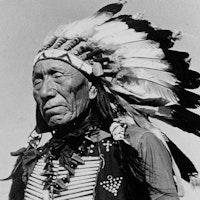It is good to have a reminder of death before us, for it helps us to understand the impermanence of life on this earth, and this understanding may aid us in preparing for our own death.
Black Elk [Heȟáka Sápa]

That World Which Is Real
Topic: Life Beyond Death & the Spirit World
It is good to have a reminder of death before us, for it helps us to understand the impermanence of life on this earth, and this understanding may aid us in preparing for our own death. He who is well prepared is he who knows that he is nothing compared with Wakan Tanka, who is everything; then he knows that world which is real.
Heȟáka Sápa, commonly known as Black Elk, was born in December 1863 along the Little Powder River in what is now Wyoming. He was a member of the Oglala Lakota (Sioux) and a second cousin to the renowned war leader Crazy Horse. From a young age, Black Elk experienced profound spiritual visions that would shape his life and destiny. At the age of nine, during a severe illness, he had a vision in which he encountered the Six Grandfathers, spiritual beings who bestowed upon him gifts and powers, including the ability to heal. This vision set him on the path to becoming a wičháša wakȟáŋ, or holy man, a role he embraced throughout his life.
Black Elk's life was marked by significant historical events and personal transformations. He participated in the Battle of the Little Bighorn in 1876 and witnessed the tragic Wounded Knee Massacre in 1890. In the late 1880s, he traveled to Europe with Buffalo Bill's Wild West Show, where he sought to understand the ways of the white people. Upon returning to the United States, he became involved in the Ghost Dance movement, which aimed to restore the Native American way of life. Despite the suppression of this movement, Black Elk continued to serve his people as a healer and spiritual leader, blending traditional Lakota practices with his later conversion to Catholicism in 1904. He became a catechist, teaching Christianity while maintaining his Lakota spiritual beliefs.
Black Elk's legacy extends beyond his lifetime through his contributions to literature and spiritual teachings. His autobiographical accounts, shared with poet John G. Neihardt and anthropologist Joseph Epes Brown, were published in the influential works "Black Elk Speaks" and "The Sacred Pipe." These books have inspired generations and contributed to the revival of Native American culture and spirituality. Black Elk's ability to integrate his Lakota heritage with his Christian faith exemplifies his resilience and adaptability. His life and teachings continue to resonate, symbolizing a bridge between cultures and a testament to the enduring spirit of the Lakota people.
The Sacred Pipe
Black Elk [Heȟáka Sápa], and Joseph Epes Brown. The Sacred Pipe: Black Elk's Account of the Seven Rites of Oglala Sioux. University of Oklahoma Press, 1953.

Black Elk [Heȟáka Sápa]
Theme: Life Beyond Death

About This Black Elk (Heȟáka Sápa) Quotation [Commentary]
Black Elk (Heȟáka Sápa) begins with a simple yet steadying truth: “It is good to have a reminder of death before us.” This reminder is not meant to provoke fear, but to help us “understand the impermanence of life on this earth.” Holding death in view clarifies the nature of life—it is brief, changing, not to be clung to. In recognizing this, we begin to prepare—not only for death itself, but for the life that leads to it. Black Elk offers this awareness as a kind of guidance, a way to live with more honesty and readiness.
He continues: “He who is well prepared is he who knows that he is nothing compared with Wakan Tanka, who is everything.” Preparation, then, is not a strategy but a turning of the heart. It begins with humility—knowing that one’s life is not ultimate, but part of something much greater. To know this is to shift attention from the passing world to “that world which is real.” The readiness Black Elk speaks of is not an idea or emotion—it is the result of seeing life clearly, and of recognizing the presence of the Great Spirit at the center of it.
The theme of life beyond death appears quietly but clearly. Black Elk does not describe death as a break or an end. Rather, the “understanding” that comes from remembering death “may aid us in preparing.” That preparation is a movement toward Wakan Tanka, whose reality stands beyond the temporary. By remembering what passes, we remember what remains. In this, death becomes part of the path—one that leads not away from life, but toward “that world which is real.”
Black Elk
Heȟáka Sápa (Black Elk) was a famous wičháša wakȟáŋ (medicine man and holy man) of the Oglala Lakota (Sioux) who lived in the present-day United States, primarily South Dakota. He was a second cousin of the war chief Crazy Horse… The Sacred Pipe is Black Elk’s Account of the Seven Rites of the Oglala Sioux (1953), as told to Joseph Epes Brown.
Additional Black Elk Quotes
Resources
Related Quotes
Copyright © 2017 – 2025 LuminaryQuotes.com About Us